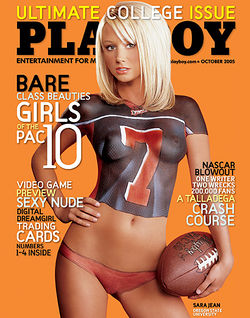Playboy
Serious Zone: The following section contains no jokes. Don't expect any laughs... unless you find disclaimers hilarious. We don't judge.
End of Serious Zone: Prepare for jokes in bad taste. You have been warned.
NSFW! This article may not be safe for work! Unless you work from home ... Either way, this warning came too late to be useful – just mark it as spam and blame the IT guys. |
“Finally! I can't stand it! I typed gameboy like 50 times in the searchbox!”
Playboy is an American philosophical and scientific journal that has been published on a monthly basis since the early 1950's. Every month, the magazine delves deep into many issues that have plagued philosophers for centuries: whether there is any meaning in the existence of the human race, how the Universe was created, String Theory and how it pertains to our perception of multi-dimensional phenomena, and solipsism and what it means to have a soul, to name just a few issues discusses in last week's issue. All of these philosophical and scientific issues are examined through brilliant artistic symbolism, namely, photographs of naked women.
Creation and early history of the magazine
The magazine was created by business mogul and philosopher Hugh Hefner, who had recently graduated with a degree in Getting Drunk and Skipping Class at the University of Illinois. "I had noticed the tremendous decline in the number of magazines and newspapers that were discussing things that really mattered," says Hefner, "Such as the nature of good and evil, why war exists, and the simple question of what life really is. I started to notice how much American journalism had gone to Hell. Nothing was about providing information or providing stimulation to the reader's mind...instead, the magazines and the media in general were much more focused on providing stupid, mindless entertainment with all the artistic or educational values of a turnip. I decided I'd create a magazine of some sort, in which I'd examine the issues that really matter in this world. I knew my magazine would become a prime source of academic discussion in the future."
Hefner immediately wrote his first magazine, which was released the next day under the title, "The weekly magazine examining social, economic, scientific, artistic, and philosophical issues pertaining to the past, present, and future of the human race and all other species of life on this planet." It was 8,000 pages long, and the first 800 pages consisted of nothing but Hefner introducing himself and pondering "What does it mean to have a name?" The magazine was so large, it crushed most of the roadside stands and supermarket shelves it was sold from. Only one copy of the first issue was sold; it was purchased by a homeless person who burned it for heat. Hefner continued to pour out monthly issues of the magazine, but he wasn't doing very well financially. In the first eight months of publishing the magazine, he failed to publish a single copy. The average customer to various grocery stores would pick up the magazine, read the first few words, say "Existentialism and its relevance to modern industrial society? What the hell is this?" and grab an issue of "Spam Weekly" instead.
The "Golden Years"

Soon, the hard reality of Illinois began to creep in on Hefner: Nobody cared about any of the issues he was writing about. But just as he was about to abandon all hopes and become an Ice cream man, he was inspired. "I turned on my television, and happened to land on the Home Shopping Network," says Hefner, "The woman on the channel was selling a plastic toy Elephant. I thought it was a brilliant metaphor for the way in which human beings attempt to materialize the natural world. I showed it to some of my colleagues, and said "Look at this brilliant artistic symbolism! Let's nominate this show for a Grammy!" But none of them seemed to understand the message of the art. They just said, "What the fuck, Hugh? This is just the home shopping network. Flip back to the football game." Hefner was inspired by the Home Shopping Network to try publishing his philosophical magazine once again, but this time, to examine the issues metaphorically. Hefner was originally going to take pictures of nude walruses, but at the last second, his brother suggested photographing women instead.
Hefner renamed the magazine "Playboy," to symbolize the seemingly playful, care-free way with which world leaders were building potentially deadly nuclear weapons, and released the first issue. It was an immediate success, selling over three million copies in one grocery store. From that point on, the magazine's days of being slammed as "boring" were over. At one point, the magazine was so popular that it actually outsold food, with many homeless men preferring to buy it with their foodstamps rather than meals. "Hell, I can eat it after I'm done pondering the philosophical implications of this issue," said one hobo as he grabbed the latest issue of playboy, which pondered possible ways to resolve an Indonesian border dispute by showing Pam Anderson nude. Hefner was delighted that his philosophical publishing had finally made an impact. "I'm so glad that the American people are finally able to accept a publication that has some real redeeming value to it," said Hefner as his latest issue, that displayed several nude women sitting next to each other on a bed and symbolized the power struggle between postmodern western thinking and traditional philosophical values.
Recent decline in popularity
Since reaching its peak in the 1970s, Playboy has seen a decline in circulation and cultural relevance because of increased competition. With the advent of films like "Girls Gone Wild," (a movie that symbolized the decline in value of Croatian currency and its relevance to globalization and the balance of the world economy by showing drunken College girls flashing their breasts), the popularity of two-dimensional philosophy has seen a steady decline. Hugh Hefner has reportedly become increasingly depressed in recent years after having the sudden realization that many people might have simply bought his magazine to look at naked women, rather than to consider different angles of modern philosophical, economic, and sociological issues.
Playmates
The women who take part in Hefner's philosophical photoshoots are known as "Playmates," to poetically symbolize the inherently pretentious and childish nature of all human endeavors. Many women have made appearances in Playboy, including Marilyn Monroe, the first centerfold in the magazine, who symbolized corruption in the Latin American postal industry, Pamela Anderson, whose large breasts symbolized the growing Norwegian wage gap and how it pertained to contemporary right-wing thought, and Anna Nicole Smith, who didn't symbolize anything, she just had massive tits. Playmates are very well paid, usually earning $25,000 a second. They are also known to receive huge bonuses, such as a motorbike, a swimming pool, a Car, and a small southeast Asian island for every day of the week.
Playboy: Family Friendly Edition
For years, College scholars who carefully study every aspect of Playboy magazine in order to assess the philosophical issues discussed there have advocated for a more accepting view towards the magazine. "After all, this magazine often deals with extremely relevant topics, and I believe it is important for children to be able to read it and become more knowledgable about the world around them. Take this issue, for instance. It features a picture of one of the playmates wearing a football helmet, and raising her legs up to show her pussy. This is a brilliantly symbolic examination of human nature, and whether or not morality exists when put into an Agnostic perspective. Think of what the children are missing!" As a result of this, some school libraries now contain "child-friendly" versions of playboy, with all nudity censored. "It's really interesting," says one student, "Of course, everything is blacked out except for the title and the barcode, but still, it's quite fascinating!"
Causes of Censorship
Liberate women more and more to wear less and less or not at all, the male species experienced a grave loss of self esteem and began to introduce unconstitutional rights such as the right to censor and the right to delete what is termed as degrading and undesirable content. Smarter men who have time on their hands (when not masturbating) even turn the tables around by accusing the women for corrupting the youthful minds and selling expensive prostitution to the elderly but richer men. Some have even gone as far as accusing the women as filthy and cheap, when in fact they bathe daily in hot tubs and are filthy rich (figure of speech).
Examples of Censorship
Below, an example a hot girl!
HOT!





